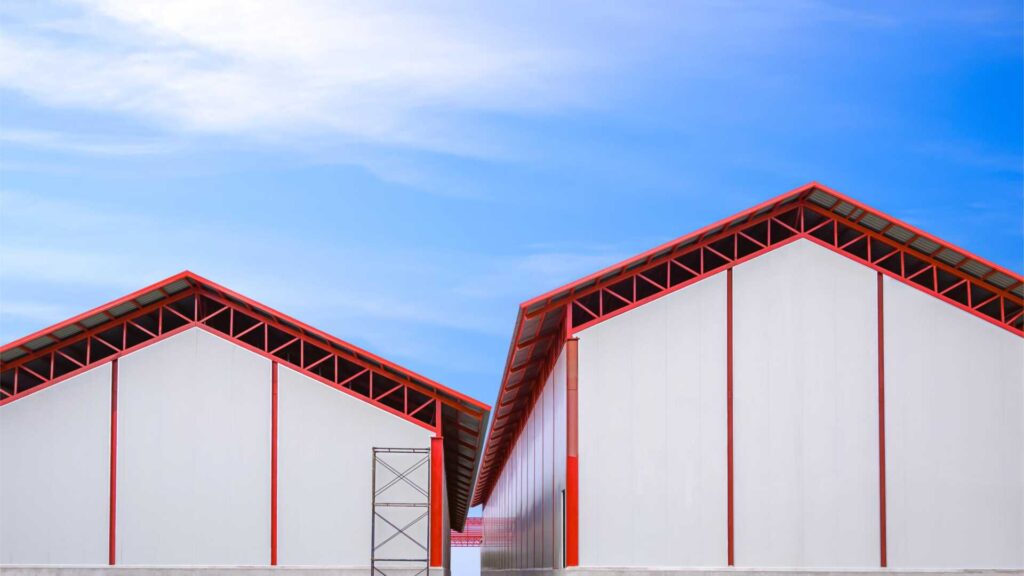
Contents
When considering enhancing industrial metal structures with enduring elements, you may be intrigued by the creative ways in which eco-friendly practices can transform traditional construction methods. Industrial metal structures can evolve into environmentally aware and resource-efficient structures by incorporating eco-conscious insulation options, energy-saving lighting solutions, recycled materials, water conservation features, green roof installations, and solar panel integration. The potential benefits extend beyond mere aesthetics, offering a glimpse into a future where enduring elements and industrial functionality harmonize smoothly.
Key Takeaways
- Utilize recycled steel components for sustainable construction.
- Incorporate energy-efficient systems for reduced environmental impact.
- Integrate solar panels to enhance energy efficiency and sustainability.
- Implement green roof installations for urban biodiversity and energy savings.
- Choose eco-friendly materials like recycled denim insulation for green design.
Sustainable Insulation Options
When considering eco-friendly insulation options for industrial metal structures, utilizing materials such as recycled denim or cellulose fiber can provide both environmental benefits and effective thermal performance.
These environmentally friendly materials offer an eco-conscious solution for insulating industrial metal structures while ensuring excellent thermal performance.
Recycled denim insulation is made from post-consumer denim, diverting waste from landfills and reducing the need for new raw materials. This environmentally friendly material provides a high level of thermal resistance, helping to maintain a comfortable temperature within your metal structure while reducing energy costs.
Additionally, cellulose fiber insulation, made from recycled paper products, offers another cost-effective and eco-conscious option for insulating industrial buildings. Cellulose fiber insulation is treated for fire resistance and pest control, ensuring a safe and durable insulation solution.
Energy-Efficient Lighting Solutions
Utilize advanced LED lighting systems to enhance energy efficiency and illumination in industrial metal structures. LED fixtures are a popular choice due to their high energy efficiency and long lifespan. You can further enhance energy usage by incorporating smart controls into these fixtures. Smart controls allow for precise adjustment of lighting levels based on occupancy patterns and natural light availability, a concept known as daylight harvesting. This reduces energy consumption and creates a more comfortable and productive work environment.
Occupancy sensors are another essential component of energy-efficient lighting solutions in industrial settings. These sensors detect movement within a space and adjust lighting accordingly. By integrating occupancy sensors with LED fixtures, you can make sure that lights are only on when needed, greatly reducing energy waste. This automated approach saves energy and eliminates the need for manual adjustments, streamlining operations and enhancing overall efficiency.
Incorporating these advanced technologies into the lighting design of industrial metal structures can result in significant cost savings and environmental benefits. You can create a well-lit, energy-efficient workspace that promotes sustainability and productivity by combining LED fixtures with smart controls and occupancy sensors.
Recycled Materials Integration
Consider incorporating recycled materials into the construction of industrial metal structures to enhance environmental responsibility and reduce environmental impact. By integrating recycled steel and upcycled decor, you can achieve an eco-friendly design that decreases waste and adds unique character to the structure.
Here are some key elements to keep in mind when incorporating recycled materials:
Recycled Steel: Utilize recycled steel beams, columns, and other structural components to lessen the need for new steel production, reducing energy consumption and greenhouse gas emissions.
Upcycled Decor: Integrate upcycled materials like reclaimed wood or repurposed metal accents for interior and exterior design elements, adding a touch of creativity and environmental consciousness.
Environmentally Friendly Landscaping: Enhance the surrounding environment by including environmentally friendly landscaping features such as recycled plastic pavers, reclaimed stone pathways, or rain gardens to manage water runoff effectively.
Green Design: Embrace an overall green design approach by selecting materials with recycled content, implementing energy-efficient systems, and considering the life cycle impacts of each component used in the construction process.
Water Conservation Features
Incorporating efficient plumbing systems that minimize water wastage can enhance the water conservation features of industrial metal structures.
Implementing rainwater harvesting solutions allows you to collect and store rainwater for various industrial purposes, reducing the dependency on freshwater sources.
Additionally, utilizing greywater recycling methods can help recycle wastewater from sinks and showers, providing an eco-friendly way to conserve water resources within industrial facilities.
Efficient Plumbing Systems
Implementing water-saving fixtures and efficient plumbing systems in industrial structures is essential for reducing water consumption and promoting sustainability in operations.
When it comes to enhancing your industrial metal structure with efficient plumbing systems, consider the following:
Water-Saving Fixtures: Installing low-flow faucets, toilets, and urinals can greatly reduce water usage without compromising functionality.
Pipe Materials: Opt for durable and corrosion-resistant pipe materials like PVC, PEX, or copper to ensure longevity and prevent leaks.
Smart Irrigation Systems: Incorporating smart irrigation technology allows for precise water delivery based on real-time weather data and plant needs, avoiding overwatering.
Leak Detection: Implementing leak detection systems with sensors can help identify and address leaks promptly, preventing water wastage and potential damage to the structure.
Rainwater Harvesting Solutions
Consider integrating rainwater harvesting solutions for long-term water management in industrial metal structures to improve water conservation features. Rainwater harvesting involves collecting and storing rainwater for various purposes, such as irrigation and landscaping.
By installing filtration systems, you can make sure that the harvested rainwater is clean and suitable for use in irrigation systems.
Storage tanks are essential components of rainwater harvesting systems, allowing you to store collected rainwater for later use. These tanks come in various sizes to accommodate different water storage needs.
The stored rainwater can then be used for irrigation systems, reducing the reliance on traditional water sources.
One of the significant benefits of rainwater harvesting is the positive impact it can have on landscaping. Using harvested rainwater for watering plants and landscapes can result in healthier vegetation and reduced water bills.
Additionally, rainwater harvesting promotes sustainability and reduces the strain on municipal water supplies. Incorporating rainwater harvesting solutions into industrial metal structures can enhance water conservation efforts and contribute to a more environmentally friendly operation.
Greywater Recycling Methods
Consider integrating greywater recycling methods as part of your water conservation features within industrial metal structures to enhance water usage and sustainability. Greywater, which is wastewater from sources like sinks and showers but doesn’t include sewage, can be effectively recycled to reduce water consumption.
Here are some key methods to implement greywater recycling:
Filtration Systems: Utilize advanced filtration systems to remove impurities and contaminants from greywater, making it safe for various non-potable uses.
Irrigation Methods: Implement irrigation systems that utilize treated greywater for watering plants and landscaping, reducing the reliance on freshwater sources.
Storage Tanks: Install storage tanks to collect and store greywater for future use, ensuring a consistent supply for different applications.
Treatment Processes: Employ treatment processes such as disinfection or biological treatment to further purify greywater before reuse, maintaining high water quality standards.
Green Roof Installations
You’ll explore the benefits of incorporating green roofs on industrial metal structures, understand the installation process overview, and examine the environmental impacts.
Green roofs offer advantages such as enhanced energy efficiency, stormwater management, and biodiversity support.
The installation process involves layers of waterproofing, drainage, growing medium, and vegetation, all meticulously planned to ensure structural integrity and sustainability.
Examining the environmental impact includes evaluating carbon sequestration, temperature regulation, and overall ecosystem enhancement that green roofs provide.
Benefits of Green Roofs
The installation of green roofs on industrial metal structures can provide numerous environmental and economic benefits. Green roofs offer a range of advantages that contribute to eco-friendly building practices and enhance the structure’s overall functionality.
Here are some key benefits to keep in mind:
Promoting Urban Biodiversity: Green roofs help create habitats for birds, insects, and plants in urban areas, supporting local ecosystems and enhancing biodiversity within the cityscape.
Improved Stormwater Management: By absorbing rainwater and reducing runoff, green roofs help alleviate pressure on stormwater systems and decrease the risk of flooding in urban environments.
Energy Efficiency: Green roofs act as natural insulators, reducing the need for heating and cooling within the building and lowering energy costs.
Extended Roof Lifespan: The vegetation on green roofs protects the roofing membrane from UV radiation and extreme temperatures, extending the lifespan of the roof and reducing maintenance costs.
Embracing green roofs on industrial metal structures benefits the environment and contributes to a more eco-friendly and cost-effective building design.
Installation Process Overview
Installing green roofs on industrial metal structures involves a detailed process that integrates environmental benefits with structural considerations. The installation typically begins with structural modifications to ensure the metal structure can support the added weight of the green roof system. This may include reinforcing beams or adding extra support structures as necessary.
Once the structural enhancements are in place, the process moves on to installing the green roof components. Aesthetic improvements are also considered during the installation process to ensure the green roof complements the industrial metal structure’s overall appearance.
Cost-effective solutions are often utilized to enhance the installation process and keep expenses manageable. Project timelines are carefully planned to ensure efficient completion of the installation while meeting quality standards.
Coordinating with skilled professionals and suppliers is vital to ensuring a successful green roof installation that enhances the industrial metal structure’s sustainability and visual appeal.
Environmental Impact Analysis
An analysis of the environmental impact of green roof installations on industrial metal structures reveals significant benefits for long-term ecosystem health and environmental sustainability. When examining the potential for green roofs, conducting a life cycle assessment and carbon footprint analysis is essential to comprehend the overall environmental implications.
Here are some key points to keep in mind:
Enhanced Air Quality: Green roofs serve as natural air purifiers, capturing pollutants and particulate matter, thereby improving the air quality around industrial metal structures.
Mitigated Urban Heat Island Effect: By offering natural insulation, green roofs assist in reducing the overall temperature of urban areas, alleviating the heat island effect and decreasing energy usage for cooling systems.
Encouragement of Biodiversity: Green roofs establish habitats for various plant species, insects, and birds, promoting biodiversity within urban environments.
Management of Stormwater: These installations help soak up rainwater, decrease runoff, and ease the strain on stormwater systems, supporting sustainable water management practices.
Solar Panel Integration
Consider incorporating solar panels onto industrial metal structures for increased energy efficiency and sustainability. By integrating solar panels onto the rooftops of these structures, you can greatly enhance their overall energy performance. Solar panel efficiency has improved over the years, making them a dependable source of renewable energy. This integration benefits the environment and provides substantial cost savings in the long run.
Rooftop integration of solar panels allows for ideal exposure to sunlight, maximizing energy production. The angled design of industrial metal structures offers a perfect platform for solar panel installation, ensuring effective energy capture throughout the day. With advancements in technology, solar panels can now generate more electricity from sunlight, improving the overall energy output of these structures.
Incorporating solar panels into industrial metal structures promotes sustainability by reducing dependence on traditional energy sources. This transition to renewable energy reduces environmental impact and establishes a more eco-friendly operation. The cost savings linked with solar panel integration make it a pragmatic and efficient solution for enhancing the energy performance of industrial metal structures.
Summary
Improving industrial metal structures with eco-friendly elements can greatly decrease their environmental impact and enhance their effectiveness.
Industrial metal structures can play a vital role in combating climate change and fostering a more enduring future by integrating eco-conscious insulation, energy-saving lighting, upcycled materials, water-saving characteristics, eco-friendly roofs, and solar panels.
Recent Posts
What Are the Benefits of Tailored Metal Structures?
Imagine a well-crafted suit tailored to fit perfectly; that’s how tailored metal structures operate in
3 Tips for Long-lasting Metal Commercial Structures
When it comes to metal commercial structures, you’ll want to focus on a few key
Explore Benefits of Residential Metal Structures
It’s funny how you might stumble upon the idea of residential metal structures just when




